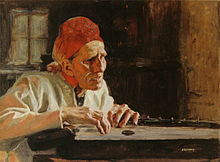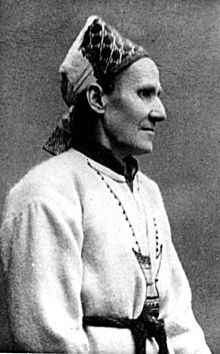Larin Parasque
Larin Paraske (* December 27, 1833 July / January 8, 1834 greg. In Lempaala , Ingermanland ; † January 3, 1904 in Metsäpirtti , South Karelia ; actually: Paraskeva Nikitina ) was a Finnish rune singer .
Life
Paraske was born in 1833 to Mikitta Mikitanpoika and Tatjana Vasilovna. Her father was the tenant of a farm ( Lampuoti ). Her interest in poetry and folklore began at an early age . She learned by heart the orally transmitted poems that were widespread in the area and soon began developing her own.
In 1851, three years after the death of her mother in 1848, her father also died. In 1853 she married the 20 years older farmer Kaurila Teppananpoika from Vaskela to secure her livelihood . Since her husband was ailing, the family depended on their income. Nevertheless, she had nine children between 1855 and 1878, but only three of them reached adulthood. For this she took care of many children at the nearby orphanage from St. Petersburg . In 1888 she became a widow.
Her life changed in 1887 when she was recommended to clergyman Adolf Nevius, who had set himself the task of documenting Finnish folk poetry . For a little money Paraske sang her poetry to him. The collaboration yielded 1,200 poems, 1,750 proverbs, 336 riddles and also some lamentations called Itkuvirsi .
In 1891 Nevius moved to Porvoo and Paraske went with him to complete the project. Over the next three years she gave numerous screenings in Porvoo and Helsinki and attracted some attention. Well-known artists such as Jean Sibelius listened to her. Albert Edelfelt and Eero Järnefelt painted portraits of her.
In 1894 Paraske returned to Vaskela. Despite her success, she remained poor. Her house was seized in the summer of 1899, after which she moved to her neighbour's sauna. The Suomalaisen Kirjallisuuden Seura granted her an artist pension in 1901. Still, she had financial problems until her death in 1904.
meaning

Today Larin Paraske is seen as a key figure and “memory” of Finnish folk poetry. She was able to recite over 32,000 verses, which made her an important source of Karelian culture. Their rune chants, which are often based on the Kalevala , have inspired numerous artists. Kullervo by Jean Sibelius is said to contain elements of Paraske's typical singing style.
The sculptor Alpo Sailo created a statue of Paraske in 1936. It was actually intended for the Kalevala House, but it was never built. Therefore, the statue was erected in 1949 in Hakasalmi Park ( Mannerheimintie , Etu-Töölö ) in Helsinki. A street in the Helsinki district of Kaarela was also named after her. Since 1985 there has been a stamp with her portrait as a motif. In 2005 she was voted 87th of the 100 most important Finns .
literature
- Senni Timonen (Ed.): Nain Lauloi Larin Paraske . Suomalaisen Kirjallisuuden Seura, Pieksämäki 1982, ISBN 951-717-237-0 .
Individual evidence
- ↑ Larin Paraske
- ↑ a b Inkerin lauluemo ( memento of the original from July 13, 2011 in the Internet Archive ) Info: The archive link was automatically inserted and not yet checked. Please check the original and archive link according to the instructions and then remove this notice.
- ↑ a b c Museovirasto Helsinki
- ↑ BBC - Sibelius Revisited 2
- ↑ Public Art ( Memento of the original from April 25, 2002 in the Internet Archive ) Info: The archive link was inserted automatically and has not yet been checked. Please check the original and archive link according to the instructions and then remove this notice.
| personal data | |
|---|---|
| SURNAME | Parasque, Larin |
| ALTERNATIVE NAMES | Paraskeva, Nikitina |
| BRIEF DESCRIPTION | Finnish rune singer |
| DATE OF BIRTH | January 8, 1834 |
| PLACE OF BIRTH | Lempaala , Ingermanland |
| DATE OF DEATH | January 3, 1904 |
| Place of death | Metsäpirtti |
